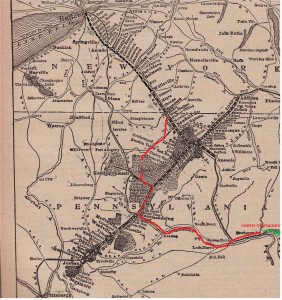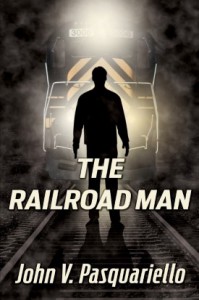Okay, It’s been quite some time since I last posted here. That’s because I’ve been busy. And while i know that The Railroad Man has been getting great reviews and capturing fans literally all across the globe, I have always had something that was bothering me about it in the back of my mind. It was not something major. In fact, it’s quite anal, and would only be of interest to the most hard-core rail buffs out there. But I never really liked where my railroad in the novel ran to. Being as intimately familiar with the railroad industry as I am, I knew that a railroad that ended in Scranton could not be a commercially plausible enterprise. This was made apparent by the Central Railroad Company of New Jersey, whose main line ran between Jersey City and Scranton. It was a railroad not unlike the Midland who’s main purpose was the transport of anthracite coal to the New York harbor. When the coal business went under in the ’30’s, so did the CNJ. It hung around like a zombie for the next 40 years before it was swept into the dustpan of the government and their “solution” for the bankruptcies that plagued northeastern railroading in the 1970’s: ConRail (Read, Penn Central plus a few extra branch lines!)
I came up with a scenario that would have justified the Midland’s continued existence and its ability to thrive while competing against railroads much larger that itself. The were predicated on the thought that there was a railroad that ran between Scranton and Buffalo, that bridged the gap between the Midland, and a railroad that ran to Chicago and the big western carriers that ran to the West Coast. Like the Midland, which was a direct clone of the Susquehanna Railroad, this second railroad was a thinly veiled Delaware and Hudson, an old-line railroad whose corporate roots dated back to the 1820’s! The D&H is never mentioned by name (As are none of any other railroads that are mentioned beyond the Midland for fear of getting jammed by licensing fees and requirements today’s railroads now require to use their images in or on anything). In the story, I refer the the D&H as “The line that runs from Scranton to Buffalo.” That’s a mouthful, but what can i do. I state that the D&H is in danger of being taken over by “One of the Midland’s mega-competitors.” This is in reference to the Norfolk Southern, one of the mega-railroads in the U.S. today. In the story, it is a fear that the D&H was going to be taken over by the NS. But that was speculation when I first wrote that. I figured such an event would not happen, at least no time too soon. Well, on November 17, 2014, which also happens to be my birthday, it DID happen! And while the take over is undergoing regulatory review, it’s usually just a rubber stamp. The D&H lines through Scranton will soon become NS’s. And in my novel, that would spell complete economic disaster for the fictional Midland Railroad. It would be cut off, and lose all its traffic as a result.
I could not let this be. It bothered me, irked me, made me question the commercial plausibility of the Midland. I knew that the line would have to get to Buffalo by some other method to connect to that critical railroad to Chicago. But how? I worked out several methods in my head. None seemed to work, or were just too unwieldy to explain. How was I going to make the railroad in my novel get to Buffalo in a believable way? And then I remembered, I did already!
A long time ago, before the novel was even thought of, I designed a model railroad that combined the NYSW with other railroads to reach Buffalo, and thus make the line more “interesting’ and economically viable. This was an exercise in alternate reality, a “what if’ scenario that never came to be, but the railroad I chose to combine the Susquehanna with shared a common name with it. I wanted to use this line in my story, but felt, due to expediency, that the shorter, simpler Midland ending in Scranton would be better suited to a person writing his first novel who was trying to build up an audience. It was a compromise I never liked, but was willing to live with. Until NS bought out the damned D&H!
Allow me here to introduce you to the Buffalo and Susquehanna. If you’ve never heard of it, that’s okay. It was abandoned in parts, the first of which went in 1915! That’s 100 years ago! But if you HAVE heard of this line, then good. You certainly are a hard-core fan. The B&S was a near-do-well line that never lived up to its promises, mostly because its backers, two brothers from Buffalo, died before it could be finished. as a result, the line, which had built from Buffalo southward, was never completed, and began to be dismantled early. In fact, its line between Buffalo and Wellsville in western New York State has been gone 100 years now! Truly, this line is the very definition of obscure. But what if they were taken over by an aggressive company that was building west from Scranton and was looking to expand wes to the Great Lakes like other coal-based railroads of the time were doing. And just when the B&S was going to throw in the towel, it gets bought up by this company, who then invests in it, makes the needed adjustments to its route structure and integrates it as their new Main Line from Jersey City to Buffalo? Look at this map:
This WAS the B&S. I replaced the Buffalo line in the upper left corner in black which had been abandoned by the time this particular map was printed. The red lines between Hickox and Austin are the proposed lines that had to be built to rearrange the route structure to make the line to Buffalo viable, which included a long tunnel through Mina Hill, shown on the map as a dotted red line. Like I said, it was proposed to do this, but it never was built. The red line east of Sinnemahoning is track constructed west by my expanded and more aggressive Midland to meet the B&S from North Newberry, a yard built just to the north of the major junction point of Newberry Junction, hence the name. With this, the Midland now stretches from the Hudson to the Great Lakes, has a very important secondary line that runs west to Punxsutawney (In the novel, this line is called “The Groundhog”), and becomes a much more formidable and economically viable if completely fictional railroad.
These changes led to several others on the novel, notably the identification and rebuilding of weak scenes, bad paragraphs and awkward sentence structures. I also made a few changes to the outfit Laura, the main female character in the novel, is wearing. It’s softer, a little less tailored than the outfit she had been wearing, more in line with her background as a graphic artist.
I’d like to think of this new 2015 Edition as my “Director’s Cut” It has better scenes, better sequencing and for the buffs out there, more railroad that the earlier version. It is now available through all 3 of my outlets. I am working with Kindle to have the updated version available as an update for those who purchased the novel already on Kindle. Smashwords seems to have this option available for those who bought the novel for their Nook, iphone and other reader devices. As for those who purchased a hard copy of the novel, I apologize. There is nothing I can do for you except ask you to buy a new copy of the 2015 edition. I believe very strongly in this version of my story. I think those of you who choose to buy it to reread will think the same way.
With this reconstructed edition of The Railroad Man, I am also making my formal farewell to the novel. I will not be revisiting it to make any further changes. It is done, and I am dome with it. I have very many things that have been sidelined for the past 5 years while I wrote, rewrote and rewrote this novel. It’s time I returned my attention to them. I will continue this blog over time, and be available to answer any and all questions you might have regarding the novel. And the novel will continue to be available. So until next time…








